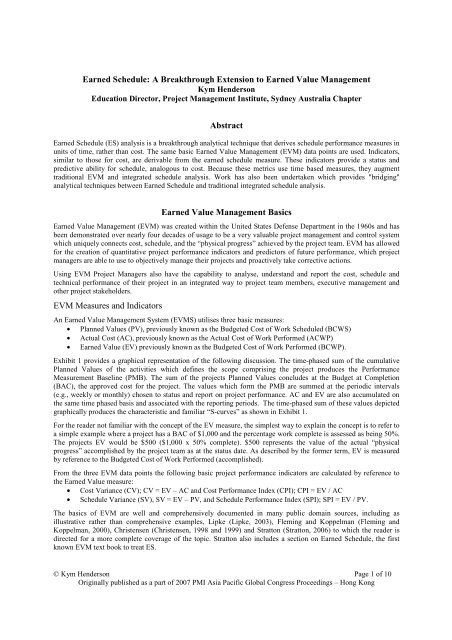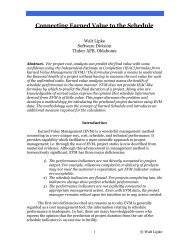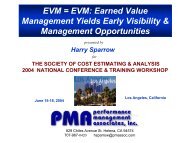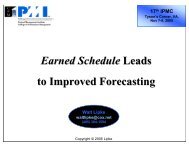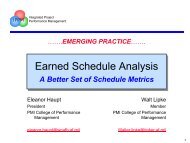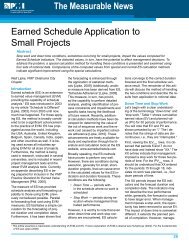Earned Schedule: A Breakthrough Extension to Earned Value ...
Earned Schedule: A Breakthrough Extension to Earned Value ...
Earned Schedule: A Breakthrough Extension to Earned Value ...
Create successful ePaper yourself
Turn your PDF publications into a flip-book with our unique Google optimized e-Paper software.
<strong>Earned</strong> <strong>Schedule</strong>: A <strong>Breakthrough</strong> <strong>Extension</strong> <strong>to</strong> <strong>Earned</strong> <strong>Value</strong> Management<br />
Kym Henderson<br />
Education Direc<strong>to</strong>r, Project Management Institute, Sydney Australia Chapter<br />
Abstract<br />
<strong>Earned</strong> <strong>Schedule</strong> (ES) analysis is a breakthrough analytical technique that derives schedule performance measures in<br />
units of time, rather than cost. The same basic <strong>Earned</strong> <strong>Value</strong> Management (EVM) data points are used. Indica<strong>to</strong>rs,<br />
similar <strong>to</strong> those for cost, are derivable from the earned schedule measure. These indica<strong>to</strong>rs provide a status and<br />
predictive ability for schedule, analogous <strong>to</strong> cost. Because these metrics use time based measures, they augment<br />
traditional EVM and integrated schedule analysis. Work has also been undertaken which provides "bridging"<br />
analytical techniques between <strong>Earned</strong> <strong>Schedule</strong> and traditional integrated schedule analysis.<br />
<strong>Earned</strong> <strong>Value</strong> Management Basics<br />
<strong>Earned</strong> <strong>Value</strong> Management (EVM) was created within the United States Defense Department in the 1960s and has<br />
been demonstrated over nearly four decades of usage <strong>to</strong> be a very valuable project management and control system<br />
which uniquely connects cost, schedule, and the “physical progress” achieved by the project team. EVM has allowed<br />
for the creation of quantitative project performance indica<strong>to</strong>rs and predic<strong>to</strong>rs of future performance, which project<br />
managers are able <strong>to</strong> use <strong>to</strong> objectively manage their projects and proactively take corrective actions.<br />
Using EVM Project Managers also have the capability <strong>to</strong> analyse, understand and report the cost, schedule and<br />
technical performance of their project in an integrated way <strong>to</strong> project team members, executive management and<br />
other project stakeholders.<br />
EVM Measures and Indica<strong>to</strong>rs<br />
An <strong>Earned</strong> <strong>Value</strong> Management System (EVMS) utilises three basic measures:<br />
• Planned <strong>Value</strong>s (PV), previously known as the Budgeted Cost of Work <strong>Schedule</strong>d (BCWS)<br />
• Actual Cost (AC), previously known as the Actual Cost of Work Performed (ACWP)<br />
• <strong>Earned</strong> <strong>Value</strong> (EV) previously known as the Budgeted Cost of Work Performed (BCWP).<br />
Exhibit 1 provides a graphical representation of the following discussion. The time-phased sum of the cumulative<br />
Planned <strong>Value</strong>s of the activities which defines the scope comprising the project produces the Performance<br />
Measurement Baseline (PMB). The sum of the projects Planned <strong>Value</strong>s concludes at the Budget at Completion<br />
(BAC), the approved cost for the project. The values which form the PMB are summed at the periodic intervals<br />
(e.g., weekly or monthly) chosen <strong>to</strong> status and report on project performance. AC and EV are also accumulated on<br />
the same time phased basis and associated with the reporting periods. The time-phased sum of these values depicted<br />
graphically produces the characteristic and familiar “S-curves” as shown in Exhibit 1.<br />
For the reader not familiar with the concept of the EV measure, the simplest way <strong>to</strong> explain the concept is <strong>to</strong> refer <strong>to</strong><br />
a simple example where a project has a BAC of $1,000 and the percentage work complete is assessed as being 50%.<br />
The projects EV would be $500 ($1,000 x 50% complete). $500 represents the value of the actual “physical<br />
progress” accomplished by the project team as at the status date. As described by the former term, EV is measured<br />
by reference <strong>to</strong> the Budgeted Cost of Work Performed (accomplished).<br />
From the three EVM data points the following basic project performance indica<strong>to</strong>rs are calculated by reference <strong>to</strong><br />
the <strong>Earned</strong> <strong>Value</strong> measure:<br />
• Cost Variance (CV); CV = EV – AC and Cost Performance Index (CPI); CPI = EV / AC<br />
• <strong>Schedule</strong> Variance (SV), SV = EV – PV, and <strong>Schedule</strong> Performance Index (SPI); SPI = EV / PV.<br />
The basics of EVM are well and comprehensively documented in many public domain sources, including as<br />
illustrative rather than comprehensive examples, Lipke (Lipke, 2003), Fleming and Koppelman (Fleming and<br />
Koppelman, 2000), Christensen (Christensen, 1998 and 1999) and Strat<strong>to</strong>n (Strat<strong>to</strong>n, 2006) <strong>to</strong> which the reader is<br />
directed for a more complete coverage of the <strong>to</strong>pic. Strat<strong>to</strong>n also includes a section on <strong>Earned</strong> <strong>Schedule</strong>, the first<br />
known EVM text book <strong>to</strong> treat ES.<br />
© Kym Henderson Page 1 of 10<br />
Originally published as a part of 2007 PMI Asia Pacific Global Congress Proceedings – Hong Kong
EVM Strengths<br />
Since the EVM method was first published as the Cost <strong>Schedule</strong> Control System Criteria (CSCS/C) by the United<br />
States Air Force in 1967 it has become widely recognised as a very valuable project management and control <strong>to</strong>ol<br />
particularly, in a his<strong>to</strong>rical context, for very large complex acquisition contracts. EVM uniquely integrates cost,<br />
schedule and technical performance information in a manner which provides quantitative project performance<br />
information on the current status of the project as well as providing predictive information on future cost<br />
performance based on the his<strong>to</strong>ric project performance achieved <strong>to</strong> date.<br />
The application of EVM, predominantly on very large-scale United States Defense Department acquisition programs<br />
has been heavily researched over with the findings of this research summarised in<strong>to</strong> the “EVM Body of Knowledge”<br />
(Fleming 1999). These research efforts typically focused on the behaviour of the EVM cost indica<strong>to</strong>rs and<br />
predic<strong>to</strong>rs. Significant research was conducted, principally by Dr David Christensen and associates in the 1990s and<br />
early 21 st century, see Christensen 1993a, 1993b, 1995, 1998, 1999, 2002a and 2002b.<br />
EV<br />
CPI =<br />
AC<br />
PV<br />
BAC<br />
$<br />
EV<br />
SPI =<br />
PV<br />
SV<br />
CV<br />
AC<br />
EV<br />
EVM Limitations<br />
Time<br />
Exhibit 1 – <strong>Earned</strong> <strong>Value</strong> Basics<br />
While EVM has many very significant achievements in quantitatively expressing and analysing project cost<br />
performance, this success has not extended <strong>to</strong> schedule performance. Reasons for the lack of corresponding schedule<br />
success includes:<br />
• The EVM schedule indica<strong>to</strong>rs are, contrary <strong>to</strong> expectation, reported in units of cost rather than time.<br />
Because cost is the unit of measure, the schedule indica<strong>to</strong>rs are counterintuitive and require a period of<br />
familiarization before EVM users and project stakeholders become familiar with them.<br />
• Because EVM schedule indica<strong>to</strong>rs are expressed in units of cost, comparison with the time based network<br />
schedule indica<strong>to</strong>rs (e.g. the critical path (CP) calculated end date) is very difficult<br />
• The much more serious issue whereby the EVM schedule indica<strong>to</strong>rs always return <strong>to</strong> unity at project<br />
completion. The EV always equals the final PV, the BAC. Therefore the SV always returns <strong>to</strong> zero and<br />
SPI always returns <strong>to</strong> one irrespective of duration based project delay. The schedule indica<strong>to</strong>rs also fail for<br />
projects which continue <strong>to</strong> execute beyond the planned completion date.<br />
Over time EVM practice and research efforts have focused primarily on cost because these “quirks of algebra” with<br />
the EVM schedule indica<strong>to</strong>rs are well known and unders<strong>to</strong>od by experienced EVM practitioners. While the schedule<br />
indica<strong>to</strong>rs are available, they are not relied upon <strong>to</strong> the same extent as the indica<strong>to</strong>rs for cost. The resultant project<br />
management impact from the behaviour of the EVM schedule indica<strong>to</strong>r issues is that cost and schedule analyses of<br />
project status and performance have become disconnected. Cost analysts view the EVM cost reports and indica<strong>to</strong>rs<br />
while schedulers update and analyse the network schedule. For large projects and programs, these separate skills<br />
may be segregated and the respective analyses not reconciled.<br />
© Kym Henderson Page 2 of 10<br />
Originally published as a part of 2007 PMI Asia Pacific Global Congress Proceedings – Hong Kong
It has been a long expressed desire by EVM practitioners <strong>to</strong> have the ability <strong>to</strong> perform schedule analysis and<br />
prediction from EVM data in a similar manner <strong>to</strong> cost. Various approaches <strong>to</strong> using EVM data for this analysis have<br />
been proposed and studied from time <strong>to</strong> time. Anbari (Anbari 2003) provides a summary of those “pre ES”<br />
techniques of using EVM data for schedule analysis. However, none of those methods have proven <strong>to</strong> be satisfac<strong>to</strong>ry<br />
for both early and late finishing projects. Another recent method, also first published in the March 2003 edition of<br />
the Measurable News is now known as “<strong>Earned</strong> Duration”, proposed by Jacob (Jacob, 2003).<br />
<strong>Earned</strong> <strong>Schedule</strong> Concept<br />
Lipke conceived the ES concept during 2002 and published the ES seminal paper “<strong>Schedule</strong> is Different” (Lipke<br />
2003) in the March 2003 edition of the PMI College of Performance Management journal, The Measurable News.<br />
As described by Lipke in the seminal paper (Lipke 2003, p12):<br />
The idea of <strong>Earned</strong> <strong>Schedule</strong> is analogous <strong>to</strong> <strong>Earned</strong> <strong>Value</strong>. However, instead<br />
of using cost for measuring schedule performance, we would use time.<br />
<strong>Earned</strong> <strong>Schedule</strong> is determined by comparing the cumulative BCWP earned <strong>to</strong><br />
the performance baseline, BCWS. The time associated with BCWP, i.e. <strong>Earned</strong><br />
<strong>Schedule</strong>, is found from the BCWS S-curve.<br />
An alternative explanation is that the ES idea is <strong>to</strong> identify the time at which the amount of EV accrued should have<br />
been earned. By determining this time, time-based indica<strong>to</strong>rs can be formed <strong>to</strong> provide schedule variance and<br />
performance efficiency management information. Lipke also explicitly acknowledged:<br />
This concept of projecting BCWP on<strong>to</strong> BCWS is not truly new. It is<br />
illustrated in many books dealing with EVM (including Mr. Fleming’s book)<br />
(Fleming and Koppelman, 2000, pp138-140).<br />
Fleming and Koppelman and Anbari (Anbari, 2003) also make it clear that the concept of predicting a projects time<br />
duration using EVM data is not new. What is new is that while the ES measure could continue <strong>to</strong> be determined<br />
graphically as per the previous practice, “the concept becomes much more useful when facilitated as a calculation”.<br />
Exhibit 2, The <strong>Earned</strong> <strong>Schedule</strong> Concept, illustrates how the ES measure is obtained as a calculation.<br />
As expressed in its simplest non technical form by Strat<strong>to</strong>n (Strat<strong>to</strong>n 2005, p3):<br />
<strong>Earned</strong> <strong>Schedule</strong> (ES) is the point in time when the current <strong>Earned</strong> <strong>Value</strong><br />
was <strong>to</strong> be accomplished.<br />
As described by Lipke in the seminal paper (Lipke 2003, p12):<br />
More explicitly, <strong>Earned</strong> <strong>Schedule</strong> (ES) is computed as illustrated by Figure<br />
4 [Exhibit 2]. The cumulative value of ES is found by using BCWP <strong>to</strong><br />
identify in which time increment of BCWS the cost value occurs. The value<br />
of ES then is equal <strong>to</strong> the cumulative time <strong>to</strong> the beginning of that<br />
increment (e.g., months) plus a fraction of it. The fractional amount is<br />
equal <strong>to</strong> the portion of BCWP extending in<strong>to</strong> the incomplete time increment<br />
divided by the <strong>to</strong>tal BCWS planned for that same time period.<br />
Expressed algebraically, ES cum is the number of completed PV time increments EV exceeds PV plus the fraction<br />
of the incomplete PV increment in the unit of time (i.e. weekly or monthly) being utilised.<br />
Therefore ES cum = C + I where:<br />
C = number of time increments where EV exceeds PV; and<br />
I = (EV – PVC) / (PVC+1 – PVC)<br />
Since ES is calculated cumulatively, periodic ES is calculated by simply subtracting the current period ES<br />
cumulative (cum) by the preceding period:<br />
ES period(n) = EScum(n) – EScum(n-1)<br />
From the foregoing it can be seen that:<br />
• The incremental portion (I) only of the ES cum amount is calculated using a linear interpolation; and<br />
© Kym Henderson Page 3 of 10<br />
Originally published as a part of 2007 PMI Asia Pacific Global Congress Proceedings – Hong Kong
• By definition, the incremental portion (I) will always be a fractional amount which will be >= 0 and < 1.<br />
Actual Time cum (AT) is the elapsed time which has been expended since the start of the project. AT period is<br />
normally equal <strong>to</strong> 1, being:<br />
ATperiod(n) = ATcum(n) – ATcum(n-1)<br />
Continuing with Lipke’s definitions, (Lipke 2003, p12):<br />
Using ES, indica<strong>to</strong>rs can be formed which behave appropriately and<br />
analogously <strong>to</strong> the cost indica<strong>to</strong>rs:<br />
<strong>Schedule</strong> Variance: SV(t) = ES – AT<br />
<strong>Schedule</strong> Performance Index: SPI(t) = ES / AT<br />
where AT is the actual time<br />
The <strong>Schedule</strong> Variance, SV(t), is positive when the ES exceeds AT, and, of<br />
course, is negative when it lags. The <strong>Schedule</strong> Performance Index, SPI(t),<br />
is greater than 1.0 when ES exceeds AT, and, of course, is less than 1.0,<br />
when ES is less than AT. These proposed indica<strong>to</strong>rs are completely<br />
analogous <strong>to</strong> the EVM cost indica<strong>to</strong>rs, CV and CPI. The proposed schedule<br />
indica<strong>to</strong>rs are referenced <strong>to</strong> “actuals,” just as are the EVM cost<br />
indica<strong>to</strong>rs.<br />
EV<br />
SPI =<br />
PV<br />
SV = EV − PV<br />
PV<br />
ES<br />
SPI(t) =<br />
AT<br />
SV(t) = ES − AT<br />
Projection of EV<br />
on<strong>to</strong> PV<br />
$$<br />
EV<br />
ES = Jan thru May + Portion of June<br />
EV - PV(May)<br />
ES = 5 +<br />
PV(June) - PV(May)<br />
AT = 7<br />
J F M A M J J A S O N<br />
Retrospective Studies Using Real Project Data<br />
Time<br />
Exhibit 2 – The <strong>Earned</strong> <strong>Schedule</strong> Concept<br />
<strong>Earned</strong> <strong>Schedule</strong> Evolution<br />
The initial paper was followed by the complimentary paper by Henderson, (Henderson 2003). Using EVM data from<br />
several completed real information technology projects, this paper independently verified that the ES measure and<br />
its derivative SV(t), and SPI(t) (denoted with (t) suffixes) functioned as described in Lipke’s seminal paper.<br />
The behaviour of the ES measure and indica<strong>to</strong>rs has been verified and placed in the public domain many times by<br />
practitioners using real project data from various types of projects. The findings of Vanhouke and Vandevoorde<br />
© Kym Henderson Page 4 of 10<br />
Originally published as a part of 2007 PMI Asia Pacific Global Congress Proceedings – Hong Kong
have been published in the respected academic journals, the International Journal of Project Management (IJPM),<br />
and Journal of Operations Research (JORS), (Vanhouke & Vandevoorde 2006a and 2006b).<br />
As an illustrative example, Exhibit 3 compares the behaviour of the traditional EVM <strong>Schedule</strong> Variance (denoted<br />
with ($) suffixes) <strong>to</strong> the behaviour of the ES SV(t) on the second y axis in a “real project” late finish example. SV(t)<br />
correctly shows the week on week schedule delay experienced by this project as a result of a “s<strong>to</strong>p work” status<br />
from weeks 19 <strong>to</strong> 26 and correctly display the -14 week schedule delay experienced at project completion.<br />
This example also illustrates the breakdown of the predictive utility of SV($) (and SPI(t)) after the planned project<br />
completion in week 20 was exceeded. SV($) “straight-lined” as the:<br />
• Project remained at around 80% complete until the s<strong>to</strong>p work was resolved in week 26; and<br />
• No further PV on the PMB was available after the planned completion date (and BAC) was exceeded.<br />
After the dependencies causing the s<strong>to</strong>p work situation were resolved in week 26 SV($) commenced the inevitable<br />
return <strong>to</strong> zero at project completion, in spite of the extensive period of duration based schedule delay actually<br />
experienced.<br />
Commercial IT Infrastructure Expansion Project Phase 1<br />
Cost and <strong>Schedule</strong> Variances<br />
at Project Projection: Week Starting 15th July xx<br />
CV cum SV cum Target SV & CV SV (t) cum<br />
Dollars (,000)<br />
20<br />
0<br />
-20<br />
-40<br />
-60<br />
-80<br />
-100<br />
-120<br />
-140<br />
2<br />
0<br />
-2<br />
-4<br />
-6<br />
-8<br />
-10<br />
-12<br />
-14<br />
Weeks<br />
-160<br />
1 2 3 4 5 6 7 8 9 10 11 12 13 14 15 16 17 18 19 20 21 22 23 24 25 26 27 28 29 30 31 32 33 34<br />
Elapsed Weeks<br />
-16<br />
Exhibit 3 – “Late Finish” Project Cost and <strong>Schedule</strong> Variances<br />
Exhibit 4 provides an illustrative example of an early finish project example where the behaviour of SV($) and<br />
SV(t) were closely correlated over the life of the project, including a 3 week s<strong>to</strong>p work period which occurred from<br />
weeks 16 <strong>to</strong> 19.<br />
It was concluded that the ES indica<strong>to</strong>rs, SV(t) and SPI(t) had greater management utility in portraying and analysing<br />
actual schedule performance compared <strong>to</strong> the traditional EVM schedule indica<strong>to</strong>rs.<br />
Outcome Prediction<br />
Henderson (Henderson 2003) also identified a schedule duration predic<strong>to</strong>r (suggested but not developed by Lipke in<br />
the seminal paper) analogous <strong>to</strong> the EVM cost predic<strong>to</strong>r (known as the Independent Estimate at Complete (IEAC))<br />
for final cost, BAC / CPI.<br />
The “short form” schedule predic<strong>to</strong>r, IEAC(t) is PD / SPI(t), where PD is the planned duration of the project. An<br />
Independent Estimate of the Completion Date (IECD) formula where IECD = Project Start Date + IEAC(t) was also<br />
developed. These formulas were applied <strong>to</strong> real project data and demonstrated the potential for project duration and<br />
completion date prediction using ES.<br />
Henderson (Henderson, 2004) collaboratively further developed the ES formulae for outcome prediction by<br />
developing a “long form” formula, which mimics the similar equation for forecasting final cost: IEAC = AC +<br />
(BAC – EV) / PF, where PF is a selected cost performance fac<strong>to</strong>r. The long form schedule duration equation is<br />
© Kym Henderson Page 5 of 10<br />
Originally published as a part of 2007 PMI Asia Pacific Global Congress Proceedings – Hong Kong
IEAC(t) = AT + (PD – ES) / PF(t), where AT is the Actual Time, PD is the Planned Duration and PF(t) is a selected<br />
time performance fac<strong>to</strong>r.<br />
Henderson (Henderson 2004) also compared the outcomes predicted using the ES “short form” formula and the<br />
“pre-ES” outcome prediction techniques using EVM data described by Anbari (Anbari 2003) using real project data.<br />
This analysis demonstrated that only the ES outcome prediction techniques produced algebraically correct results<br />
and which also mimicked the behaviour of the EVM cost predic<strong>to</strong>rs.<br />
Commerical IT Infrastructure Expansion Project: Phases 2 & 3 Combined<br />
Cost and <strong>Schedule</strong> Variances<br />
as at Project Completion: Week Starting 9th Oc<strong>to</strong>ber xx<br />
Target SV & CV CV cum SV ($) cum SV (t) cum<br />
Dollars ($,000)<br />
55.0<br />
45.0<br />
35.0<br />
25.0<br />
15.0<br />
5.0<br />
-5.0<br />
-15.0<br />
-25.0<br />
1 2 3 4 5 6 7 8 9 10 11 12 13 14 15 16 17 18 19 20 21 22 23 24 25<br />
Elapsed Weeks<br />
5.0<br />
4.0<br />
3.0<br />
2.0<br />
1.0<br />
0.0<br />
-1.0<br />
-2.0<br />
Weeks<br />
Exhibit 4 – “Early Finish” Project Cost and <strong>Schedule</strong> Variances<br />
<strong>Earned</strong> <strong>Schedule</strong> Application<br />
Since the <strong>Earned</strong> <strong>Schedule</strong> seminal paper was first published by Lipke in 2003 very significant levels of interest in<br />
and adoption of the ES methodology has occurred. The Project Management Institute - College of Performance<br />
Management (PMI-CPM) interest in the new practice resulted in an “emerging practice” insert, which cited the<br />
principles of ES being included in the 2004 release of the PMI-CPM Practice Standard for <strong>Earned</strong> <strong>Value</strong><br />
Management (PMI 2004).<br />
Significant publicised applications of ES in the United States include:<br />
• United States Air Force Acquisition Integration (SAF/AQX) in acquisition oversight<br />
• Boeing Dreamliner®<br />
• Lockheed Martin [1].<br />
Known application in other countries include<br />
• Two major United Kingdom Ministry of Defence programs applying ES include the Nimrod MRA4<br />
(maritime patrol aircraft), see Higgins 2006 and Type 45 destroyer programs.<br />
• Several smaller applications, many IT related projects, have occurred in Belgium by Fabricom Airport<br />
Systems, as well as others in Australia and the USA.<br />
ES Terminology<br />
As interest in and the application of ES grew, the need for a common set of terminology was recognized. The<br />
principals and interested parties agreed <strong>to</strong> a recommendation from a meeting held at the PMI-CPM Conference in<br />
2004 that the ES terms should be parallel <strong>to</strong>, but readily distinguishable from the EVM terms. This was thought <strong>to</strong><br />
encourage the application of ES by minimising the learning curve required by existing EVM and new practitioners<br />
alike. As shown in exhibit 5, the chosen terms are readily comparable <strong>to</strong> the EVM counterpart. In most cases, the ES<br />
term is the analogous EVM term appended by the suffix “(t)” for “time”.<br />
© Kym Henderson Page 6 of 10<br />
Originally published as a part of 2007 PMI Asia Pacific Global Congress Proceedings – Hong Kong
Available <strong>Earned</strong> <strong>Schedule</strong> Resources<br />
ES information is available and readily accessible <strong>to</strong> assist current and potential users of the technique. The<br />
published papers, conference presentations and workshop materials are available from two websites:<br />
• www.earnedschedule.com (which is expected <strong>to</strong> become the primary reference point over time) and<br />
• http://sydney.pmichapters-australia.org.au/ (click Education, then Papers and Presentations).<br />
The materials on both sites are freely available for download. In addition, free Excel based calcula<strong>to</strong>rs which<br />
facilitate the application of ES are also available from the ‘www.earnedschedule.com’ site.<br />
Status<br />
Future<br />
Work<br />
Prediction<br />
EVM<br />
<strong>Earned</strong> <strong>Value</strong> (EV)<br />
Actual Costs (AC)<br />
SV<br />
SPI<br />
Budgeted Cost for Work<br />
Remaining (BCWR)<br />
Estimate <strong>to</strong> Complete (ETC)<br />
Variance at Completion (VAC)<br />
Estimate at Completion<br />
(EAC) (supplier)<br />
Independent EAC<br />
(IEAC) (cus<strong>to</strong>mer)<br />
To Complete Performance<br />
Index (TCPI)<br />
<strong>Earned</strong> <strong>Schedule</strong><br />
<strong>Earned</strong> <strong>Schedule</strong> (ES)<br />
Actual Time (AT)<br />
SV(t)<br />
SPI(t)<br />
Planned Duration for Work<br />
Remaining (PDWR)<br />
Estimate <strong>to</strong> Complete (time) ETC(t)<br />
Variance at Completion (time)<br />
VAC(t)<br />
Estimate at Completion (time)<br />
EAC(t) (supplier)<br />
Independent EAC (time)<br />
IEAC(t) (cus<strong>to</strong>mer)<br />
To Complete <strong>Schedule</strong><br />
Performance Index (TSPI)<br />
Exhibit 5 – “<strong>Earned</strong> <strong>Schedule</strong> Terminology<br />
The Way Forward<br />
Following on from the already significant levels of global interest in the ES method, follow-on papers have resulted<br />
in additional potential advances <strong>to</strong> project management theory and practice derivable from EVM and ES. Some of<br />
these papers are theoretical and academically oriented while others are practical and practitioner oriented.<br />
<strong>Earned</strong> <strong>Schedule</strong> in Action<br />
Henderson (Henderson 2005) compared the schedule outcome predictions obtained from critical path schedule<br />
analysis and the predictions obtained using the ES IEAC(t) and IECD on a small scale but time critical IT software<br />
development and enhancement project. Some of the many advantage of using ES in conjunction with critical path<br />
analysis became obvious during this project including:<br />
• The predictions obtained from ES calculations requires considerably less effort than critical path analysis,<br />
which requires detailed task-level bot<strong>to</strong>m-up updates <strong>to</strong> and analysis of the network schedule.<br />
• Direct comparison (which is not possible using the traditional EVM schedule indica<strong>to</strong>rs) between the<br />
critical path predicted completion date and ES IECD is now possible since both metrics are duration based.<br />
Connecting <strong>Earned</strong> <strong>Value</strong> the <strong>Schedule</strong><br />
Lipke (Lipke 2004) has proposed the concept of “schedule adherence” and in an extension <strong>to</strong> ES theory proposed<br />
the “p fac<strong>to</strong>r” construct as a measure of both “schedule adherence” and “process discipline”. Lipke has further<br />
developed the concept of “effective earned value” in which the “p fac<strong>to</strong>r” (a value >= 0 and < 1) is used <strong>to</strong> discount<br />
the EVM and ES metrics by work which has been performed “out of sequence” and therefore at risk of rework.<br />
© Kym Henderson Page 7 of 10<br />
Originally published as a part of 2007 PMI Asia Pacific Global Congress Proceedings – Hong Kong
For the sophisticated project and program manager, “schedule adherence” and “effective earned value” offer<br />
possibilities for being able <strong>to</strong>:<br />
• Obtain more accurate cost and schedule outcome predictions earlier in the project lifecycle than current<br />
practice allows<br />
• Measure (and therefore manage) the level of “process discipline” being implemented on a project. Process<br />
discipline can be a particularly significant issue and risk fac<strong>to</strong>r for IT projects<br />
• Quantitatively assess the risk of rework associated with undertaking work “out of sequence” as part of a<br />
deliberate management decision; and<br />
• Quantitatively being able <strong>to</strong> assess the likely band of rework being undertaken on a project without needing<br />
<strong>to</strong> undertake the no<strong>to</strong>riously difficult and time consuming task of attempting <strong>to</strong> capture “actual rework” at<br />
the detailed level.<br />
Applying <strong>Earned</strong> <strong>Schedule</strong> <strong>to</strong> Critical Path Analysis and More<br />
Lipke (Lipke 2006) further describes techniques which practitioners can apply <strong>to</strong> analyse the ES and critical path<br />
predic<strong>to</strong>rs concurrently. Lipke also stresses the importance of having an ES “drill down capability” analogous <strong>to</strong> the<br />
EVM drill capability for cost and in another theoretical development demonstrates how it is now possible, using the<br />
ES indica<strong>to</strong>rs and predic<strong>to</strong>rs, <strong>to</strong> ascertain from the EVM data that the critical path on a (notional) project has<br />
changed.<br />
As a final point, while the papers discussed provides rationale for the position that ES “bridges” the two disciplines<br />
of EVM and network schedule analysis, as for cost, neither EVM nor ES can replace bot<strong>to</strong>m-up estimation<br />
techniques. Both EVM for cost and ES for schedule provide predictive calculations, which are useful as macro<br />
methods for rapidly generating quantitative “<strong>to</strong>p down” estimates and as cross-checks of the corresponding bot<strong>to</strong>mup<br />
analysis.<br />
What’s Next<br />
The expectation is that the extraordinary level of interest in and application of ES will continue <strong>to</strong> expand and<br />
propagate. This will be coincident with the world-wide expansion of EVM and will undoubtedly be assisted by<br />
Lipke’s creditable decision <strong>to</strong> continue the long standing EVM public domain tradition for ES. ES is also expected<br />
<strong>to</strong> increase the appeal of EVM, particularly for “non-traditional” users of EVM such as commercial sec<strong>to</strong>r<br />
organisations, many of which may be primarily focused on schedule, with cost a second, albeit still important<br />
priority. ES also has potential applicability for organisations, which do not track Actual Costs for projects.<br />
Interest in and application of ES <strong>to</strong> large-scale projects and programs is also expected <strong>to</strong> increase with the United<br />
Kingdom showing leadership in this project domain (see Higgins 2006). The recent conjecture (see Lipke and<br />
Henderson 2006) that the continued use of ES will result in demand for its inclusion in EVM <strong>to</strong>ols has rapidly been<br />
realised. A free standalone ES addition <strong>to</strong> the Deltek Cobra EVM product has been developed by WST Pacific<br />
located in Adelaide, South Australia. This addition is available for free download at:<br />
http://www.evforums.net.au/forums/showthread.php?t=15 (free registration is required) [2]. The provision of ES<br />
updates by EVM <strong>to</strong>ols vendors is anticipated <strong>to</strong> occur in response <strong>to</strong> the combination of market demand and<br />
vendor’s desire <strong>to</strong> maintain product leadership positions.<br />
As the use of ES expands, it is clear that the current experience of more and more information being published, both<br />
practitioner and academically oriented, will continue <strong>to</strong> improve and mature the method leading <strong>to</strong> the rapid<br />
expansion of the “ES Body of Knowledge”. The ultimate intention is for ES <strong>to</strong> become a generally accepted addition<br />
<strong>to</strong> EVM included within EVM standards, guides, <strong>to</strong>olsets and training documents.<br />
Conclusion<br />
ES was created as a simple solution <strong>to</strong> resolve the problem of the EVM schedule indica<strong>to</strong>rs failing for late finishing<br />
projects. The ES method requires only the PV and EV data, which is already available from projects utilising EVM.<br />
Independent research conducted <strong>to</strong> date has already confirmed that, on average, ES provides better schedule<br />
prediction using EVM data than other published methods. Predicting project duration using ES is also much easier<br />
<strong>to</strong> calculate than doing detailed, bot<strong>to</strong>ms-up critical path updates, estimation and analysis.<br />
At very advanced levels, ES facilitates identification of tasks with possible impediments, constraints, or future<br />
rework. ES also has the potential <strong>to</strong> improve both cost and schedule prediction using EVM data.<br />
<strong>Earned</strong> <strong>Schedule</strong> has become a powerful new dimension <strong>to</strong> integrated project performance management and<br />
practice, which has become a breakthrough in theory and application.<br />
© Kym Henderson Page 8 of 10<br />
Originally published as a part of 2007 PMI Asia Pacific Global Congress Proceedings – Hong Kong
Notes<br />
1. The experiences of the <strong>Earned</strong> <strong>Schedule</strong> “early adopters” referenced was included at the 2005 International<br />
Integrated Performance Management Conference (IPMC) held at Tyson’s Corner, Virginia USA. The presentation is<br />
entitled “<strong>Earned</strong> <strong>Schedule</strong> Status Update and Early Adopter Applications Feedback”. Presentations by SAF/AQX,<br />
Lockheed Martin and Belgium are included in the presentation. Proprietary restrictions by Boeing have precluded<br />
publication of the slides on their experiences. The slide set referenced is available from:<br />
http://www.earnedschedule.com/Docs/ES%20Status%20Update%20IIPM%202005%20Lipke%20&%20Henderson.pdf<br />
2. Contact details for the free <strong>Earned</strong> <strong>Schedule</strong> add-on for the Deltek Cobra product are:<br />
WST Pacific: contact: Mike Boul<strong>to</strong>n (mboul<strong>to</strong>n@wstpacific.com.au), +61 8 8150 5500.<br />
References<br />
Anbari, Frank T, Ph. D. (2003, December) <strong>Earned</strong> <strong>Value</strong> Project Management Method and <strong>Extension</strong>s, Project<br />
Management Journal, Volume 34, Number 4, 12-23.<br />
Christensen, David S. (1993a March) The Estimate at Completion Problem: A Review of Three Studies. Project<br />
Management Journal, Vol 24: 37-42.<br />
Christensen, D. S., Heise, S. R. (1993b) Cost Performance Index Stability, National Contract Management Journal,<br />
Vol 25: 7-15.<br />
Christensen, D. S, An<strong>to</strong>lini, R. C., McKinney, J. W. (1995 Spring) A Review of Estimate at Completion Research,<br />
Journal of Cost Analysis and Management, 41-62.<br />
Christensen, David, Ph.d, (1998, Fall) The Costs And Benefits Of The <strong>Earned</strong> <strong>Value</strong> Management Process,<br />
Acquisition Review Quarterly<br />
Christensen, David, Ph.d, (1999, Summer) Using The <strong>Earned</strong> <strong>Value</strong> Cost Management Report To Evaluate The<br />
Contrac<strong>to</strong>r’s Estimate At Completion, Acquisition Review Quarterly<br />
Christensen, D. S., Templin, C. (2002a Spring) EAC Evaluation Methods: Do They Still Work?, Acquisition Review<br />
Quarterly, 105-116.<br />
Christensen, D. S., Rees, D. A. (2002b Winter) Is the CPI-Based EAC A Lower Bound <strong>to</strong> the Final Cost of Post A-<br />
12 Contracts?," Journal of Cost Analysis and Management, 55-65.<br />
Fleming Quentin & Koppelmann, Joel (1999), The <strong>Earned</strong> <strong>Value</strong> Body of Knowledge, Proceedings of the 30th<br />
Annual Project Management Institute 1999 Seminars & Symposium. Philadelphia, Pennsylvania, USA<br />
Retrieved from http://www.suu.edu/faculty/christensend/Pmi99qf.pdf<br />
Fleming, Quentin, & Koppelman, Joel (2000), <strong>Earned</strong> <strong>Value</strong> Project Management 2nd ed, Upper Darby, PA: Project<br />
Management Institute<br />
Henderson, Kym (2003, Summer). <strong>Earned</strong> <strong>Schedule</strong>: A <strong>Breakthrough</strong> <strong>Extension</strong> <strong>to</strong> <strong>Earned</strong> <strong>Value</strong> Theory? A<br />
Retrospective Analysis of Real Project Data,” The Measurable News, 13-23. Manuscript version retrieved<br />
from<br />
http://www.earnedschedule.com/Docs/<strong>Earned</strong>%20<strong>Schedule</strong>%20-<br />
%20A%20<strong>Breakthrough</strong>%20<strong>Extension</strong>%20<strong>to</strong>%20EVM.pdf<br />
Henderson, Kym (2004, Spring) Further Developments in <strong>Earned</strong> <strong>Schedule</strong>, The Measurable News, 15-22.<br />
Manuscript version retrieved from<br />
http://www.earnedschedule.com/Docs/Further%20Developments%20in%20<strong>Earned</strong>%20<strong>Schedule</strong>.pdf<br />
Jacob, Dave (2003, March) Forecasting Project <strong>Schedule</strong> Completion With <strong>Earned</strong> <strong>Value</strong> Metrics, The Measurable<br />
News, 1, 7, 9. Retrieved from<br />
http://www.pmi-cpm.org/members/library/Forecasting%20<strong>Schedule</strong>.jacob.pdf<br />
Henderson, Kym (2005, Spring) <strong>Earned</strong> <strong>Schedule</strong> in Action, The Measurable News, 23-30. Manuscript version<br />
retrieved from http://www.earnedschedule.com/Docs/<strong>Earned</strong>%20<strong>Schedule</strong>%20in%20Action.pdf<br />
Higgins, Mick (2006, August/September) Can You Tell the Time, Journal of the Association of Project<br />
Management, pp22-23. Article retrieved from<br />
http://www.earnedschedule.com/Docs/Can%20You%20Tell%20the%20Time.pdf<br />
Lipke, Walt. (2003, March) <strong>Schedule</strong> is Different, The Measurable News, 10-15. Retrieved from http://www.pmicpm.org/members/library/<strong>Schedule</strong>%20is%20Different.lipke(1).pdf.<br />
Manuscript versions are retrievable<br />
from http://www.earnedschedule.com/Docs/<strong>Schedule</strong>%20is%20Different.pdf<br />
© Kym Henderson Page 9 of 10<br />
Originally published as a part of 2007 PMI Asia Pacific Global Congress Proceedings – Hong Kong
Lipke, Walt. (2005, June) Connecting <strong>Earned</strong> <strong>Value</strong> <strong>to</strong> the <strong>Schedule</strong>, CrossTalk, Retrieved from<br />
http://www.stsc.hill.af.mil/crosstalk/2005/06/0506Lipke.html<br />
Lipke, Walt & Henderson, Kym (2006) <strong>Earned</strong> <strong>Schedule</strong>: An Emerging Enhancement <strong>to</strong> <strong>Earned</strong> <strong>Value</strong><br />
Management, CrossTalk, Vol 19 No. 11 26-30 Manuscript version retrieved from<br />
http://www.earnedschedule.com/Docs/<strong>Earned</strong>%20<strong>Schedule</strong>%20-<br />
%20An%20Emerging%20Enhancement%20<strong>to</strong>%20EVM.pdf<br />
Lipke, Walt (2006) Applying <strong>Earned</strong> <strong>Schedule</strong> <strong>to</strong> Critical Path Analysis and More, The Measurable News<br />
Manuscript version retrieved from<br />
http://www.earnedschedule.com/Docs/Applying%20ES%20<strong>to</strong>%20Critical%20Path%20and%20More.pdf<br />
Practice Standard for <strong>Earned</strong> <strong>Value</strong> Management (2004). Project Management Institute.<br />
Strat<strong>to</strong>n, Ray. (2006) The <strong>Earned</strong> <strong>Value</strong> Management Maturity Model, Management Concepts, Vienna VA USA<br />
Vanhoucke, Mario, Ph. D, Vandevoorde, Stephan. (2006a) A Comparison of Different Project Duration Forecasting<br />
Methods Using <strong>Earned</strong> <strong>Value</strong> Metrics, International Journal of Project Management, Volume 24, Issue<br />
289-302.<br />
Note: This paper is made available on-line at a cost of $USD 30 from Science Direct at:<br />
http://www.sciencedirect.com/<br />
Vanhoucke Mario, Ph.D & Vandevoorde, Stephan (2006b, September) A Simulation and Evaluation of <strong>Earned</strong><br />
<strong>Value</strong> Metrics <strong>to</strong> Forecast Project Duration,” Journal of Operational Research Society<br />
Note – This paper is made available on-line at a cost of $USD 10 at: www.palgrave-journals.com.<br />
© Kym Henderson Page 10 of 10<br />
Originally published as a part of 2007 PMI Asia Pacific Global Congress Proceedings – Hong Kong


